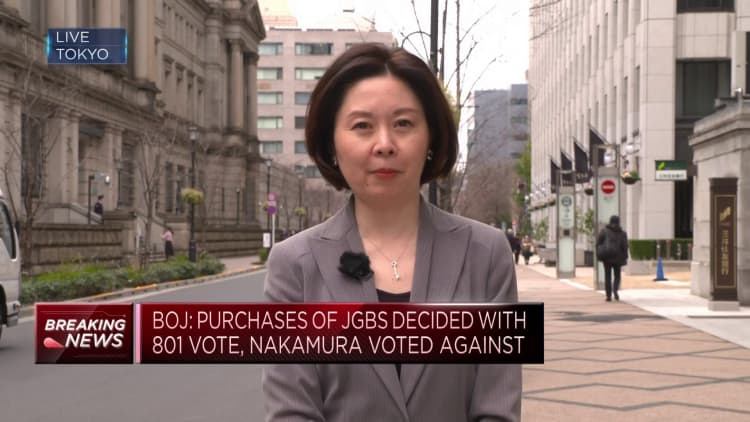Neon advertisements in Osaka’s Dotonbori district in Japan
Alexander Spatari | Moment | Getty Images
Japan’s central bank on Tuesday finally ended its experiment with negative rates and unconventional easing tools which were aimed at reflating the world’s fourth-largest economy.
The Bank of Japan’s decision came just days after Rengo, Japan’s largest federation of trade unions, said ongoing “shunto” wage negotiations between Japan Inc and unionized employees have so far yielded a provisional weighted average 3.7% spike in base pay. This was even more robust than last year’s gains, which were the steepest in three decades.
BOJ Governor Kazuo Ueda had repeatedly said these talks would be key to sustainable price increases that would inform any decision to hike rates for the first time in 17 years. BOJ policymakers expect higher salaries to lead to a virtuous spiral with domestic demand fueling inflation.
Prior to Tuesday, the BOJ had barely budged from its ultra-loose monetary policy posture despite “core-core inflation” — which excludes food and energy prices — exceeding its 2% target for more than a year, as policymakers viewed that price increases were largely imported from overseas.

“The BOJ has taken a bit of a punt today on the expectation that the very substantial wage increases in a great number of firms is actually going to deliver household spending growth,” Rob Carnell, head of Asia Pacific research at ING, told CNBC Tuesday after the BOJ released its decision after its March policy meeting.
“At the moment, they don’t know that,” he cautioned.
The BOJ will now look to utilize its short-term interest rate as its primary policy tool. It will employ an interest rate of 0.1% to current account balances held by financial institutions at the central bank from March 21, while encouraging the uncollateralized overnight call rate (another interest rate used as a policy lever by the bank) to remain at around 0 to 0.1% — effectively raising interest rates from -0.1% previously.
Shortly after the BOJ announcement, Japan’s largest banks, including Mitsubishi UFJ Financial Group, Sumitomo Mitsui Financial Group and Mizuho Financial Group, announced they would raise interest rates on ordinary yen deposits.

There are some other highlights of its policy decision:
- It said it’d abolish its yield curve control, which it used to cap longer-term interest rates at around zero; and stop its purchases of exchange-traded funds and Japan real estate investment trusts.
- The BOJ also pledged to gradually slow its purchases of commercial paper and corporate bonds, with the aim of stopping this practice in about a year.
- It would resort to “nimble responses” in the form of increased Japan government bond purchases and fixed-rate purchases of JGBs, among other things, if there is a rapid rise in long-term interest rates.
CNBC takes a look at what could next happen:
Short-term impact
The decision Tuesday sparked a sharp selloff in the Japanese yen that stretched into Wednesday.
The yen dived to its weakest against the euro since 2008 on Wednesday. The Japanese currency also fell against the dollar, trading at a four-month low of about 151 yen — weaker than the 150-yen level that previously prompted some form of intervention from Japanese authorities.
At his post-decision press conference, Ueda said a “rapid” pace of hikes is unlikely given the fragile economic outlook for the economy — a perspective that likely disappointed some Japanese yen bulls, according to Michael Brown, senior research strategist at forex broker Pepperstone.

In fact, the BOJ cautioned in its initial release it’s not about to embark on aggressive rate hikes, saying that it “anticipates that accommodative financial conditions will be maintained for the time being.”
At Tuesday’s press conference, Ueda did not commit to a timeline for a shrinkage of the BOJ’s balance sheet, nor did he give any clear signs on any further rate hikes or a terminal rate level.
The global rates team from the Bank of America — among those in the market who forecast the BOJ move following a litany of local Japanese news reports in the last week — said that they expect a “limited” immediate impact globally, as the action is already well priced.

The BofA team also noted that just because the BOJ scrapped its yield curve control framework that doesn’t mean it will lead to a sharp rise in yields on government bonds (JGBs). This is likely due to the BOJ saying it will continue purchasing government bonds worth “broadly the same amount” as before — currently about 6 trillion yen per month.
Barclays economists said that a decrease in the upper bound of offer sizes for JGBs suggested that the BOJ is looking to gradually reduce its purchases.
Longer-term concerns
One of the biggest fears is the extent of any repatriation to Japan.
Decades of accommodative monetary policy in Japan — even as other global central banks tightened policy in the last 12 months — have also concentrated carry trades in the Japanese yen, given the vast interest rate difference between Japan and the U.S. and other parts of the world, keeping the Japanese yen weak. Carry trades involve borrowing in a low-yielding currency to fund investments in higher-yielding assets elsewhere.
An unwind of the traditional yen carry trade along with a return of Japanese capital to its domestic bond market could trigger wider volatility. Japanese investors have looked elsewhere for better returns given years of artificially depressed interest rates in their home market.

But with the BOJ unlikely to aggressively hike rates, there appears to be little chance of a sharp drop in the spread between U.S. Treasurys and JGBs that currently exceeds 300 basis points, Vishnu Varathan, Mizuho’s chief Asia ex-Japan economist, said.
“Whereas [an] unexpected dovish turn by the [U.S. Federal Reserve] is a different proposition altogether.”
The Fed is due to announce its own interest rate decision on Wednesday.
In the longer term, Hayden Briscoe, head of APAC multi asset portfolio management at UBS Asset Management, said that there will be a gradual step up in bond yields, “say, 25, 50 point blocks, [to] make sure the markets are functioning.”
Briscoe thinks that it will take some time for the BOJ to make more changes to the benchmark interest rate, pointing out that “they don’t want to scare people off with short rates going up aggressively, while the year long [yields are] under pressure.”

As such, what he thinks the central bank will do is to allow the longer end of the yield curve to start “nudging” higher slowly, then if the BOJ sees demand and prices going up due to higher wages, then the bank will “start nudging again on the cash rates.”
Briscoe does say though, that this move will not be coming any time soon.
“Whether the Bank of Japan decides to hike rates a smidgeon is not what matters at the March or April meetings. It will be the totality of the announced policy shift that we will focus on, along with what it does to expectations for more of the same,” Steven Major, HSBC’s global head of fixed income research, said in a note ahead of the BOJ’s historic move.
“Something big in Japan is about to happen,” he added.
— CNBC’s Shreyashi Sanyal contributed to this story.
Correction: This story has been updated with the correct name for inflation when the metric excludes food and energy prices.
Credit: Source link












